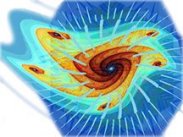 The fractal images generated for this blog have been generated using UltraFractal 3.05 - an incredibly robust package that is effectively the PhotoShop of the fractal kingdom.
The fractal images generated for this blog have been generated using UltraFractal 3.05 - an incredibly robust package that is effectively the PhotoShop of the fractal kingdom.In addition to all possible types of mathematical settings, UltraFractal allows layering (as in PhotoShop), with different blending styles adjustable (e.g. addition, difference, hue, etc.) The interface allows the designer to create or edit fractal formulas, set up color palettes, and add mathematical image transformations. There are many pre-loaded fractal types loaded - even with these you will have days of exploration as you vary coloring schemes and learn layering with fractals.
There is also a very active user group that uploads new fractal parameter files and color templates - all available for download. You can find appropriate links, and much more at Janet Parke's Ultra Fractal Resource Page.
The result is a degree of image control that is state of the art.
UltraFractal also contains a rendering engine with anti-aliasing for producing high-quality images for web and print applications.
You can try UltraFractal free for a brief period.
Note that ChaosPro is almost as powerful as UltraFractal and is freeware! Check it out!
For a good source of chaos and fractal links check out third.apex.to.fractovia by Juan Luis. This is a very nice site, and Juan is clearly interested in the fractal aesthetic:
Have in mind that this site, third.apex.to.fractovia, focuses on the artistic side of fractals, not in their mathematical aspects, so these applications are primarily intended for picture or music creation, not for studying fractals as mathematical models or for in-depth experimentation (what most of them can do in any event).
Note that some of the software generates fractal music.